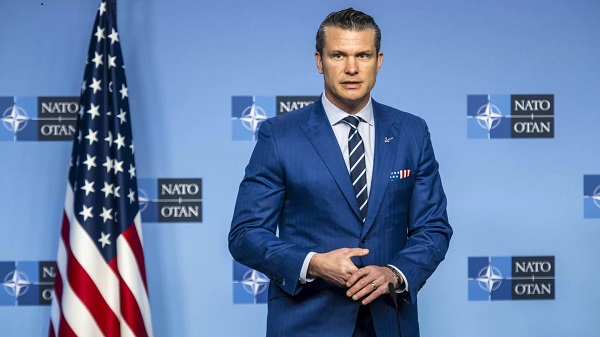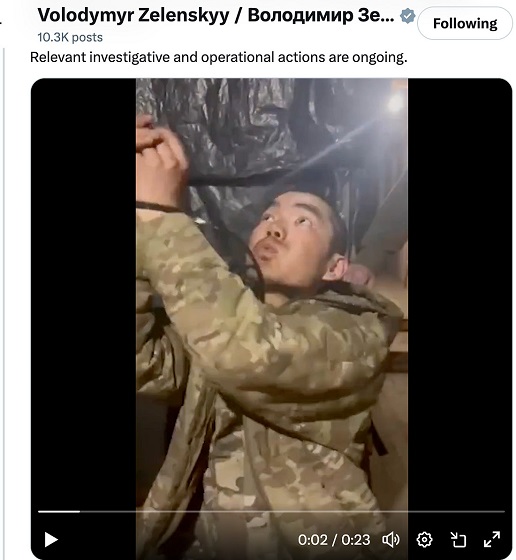conflict
U.S. Tells Europe To Handle Its Own Defense

The U.S. is no longer willing to subsidize prosperous countries that won’t defend themselves.
The Trump administration’s foreign policy gambits can be baffling: Why rename the Gulf of Mexico? What is this fixation on annexing Greenland? Does anybody really want to find out what happens if we add Canadians to the U.S. Senate? But the president is right that allies have been allowed to shift the costs of their defense to the United States for decades, and they’ve relied on the U.S. to resolve what are largely European problems. With the U.S. government spending far beyond its means, it’s time for our NATO allies to step up, as U.S. Defense Secretary Pete Hegseth recently suggested.
Blunt Word for Europe
“The United States remains committed to the NATO alliance and to the defense partnership with Europe, full stop,” Hegseth, who served as an infantry officer in Afghanistan and Iraq before taking high-profile roles with Fox News and then with the Trump administration, commented last week at a meeting of the Ukraine Defense Contact Group held in Brussels. “But the United States will no longer tolerate an imbalanced relationship which encourages dependency.”
Hegseth went on to say that any security guarantees negotiated for Ukraine after almost three long years of war between that country and invading Russian forces “must be backed by capable European and non-European troops,” but only “as part of a non-NATO mission….To be clear, as part of any security guarantee, there will not be U.S. troops deployed to Ukraine.”
But what really brought the message home for attendees was when the U.S. defense secretary emphasized that America has security obligations throughout the world, particularly regarding China. That means, with NATO, the U.S. would focus on “empowering Europe to own responsibility for its own security.” To that end, Hegseth urged U.S. allies to exceed the 2-percent-of-GDP target for defense spending set by the alliance—which most fail to meet—and to aim for 5 percent.
Hegseth’s speech threw “the world’s biggest military alliance into disarray,” according to the A.P. But the message wasn’t unanticipated, nor was the reality of competing demands on American resources entirely unappreciated. France’s President Emmanuel Macron quickly called a meeting of European leaders “to discuss European security.” NATO Secretary General Mark Rutte agreed Europe and Canada “have not paid enough over the last 40 years…. The U.S. is rightly asking for a rebalancing of that.”
Poland, which has historical reasons to fears Moscow’s intentions, is already near the 5 percent target for defense. Last March, Poland’s President Andrzej Duda praised the U.S. role in defending Europe and supporting Ukraine, but asked other NATO countries to join his country in building military capability.
Unequal Commitments to Defense
At least since the end of the Cold War, most European countries have skated by on minimal military expenditures, counting on the United States to handle any threats that might emerge. That situation continued even after Russian troops poured into Ukraine.
“The British military—the leading U.S. military ally and Europe’s biggest defense spender—has only around 150 deployable tanks and perhaps a dozen serviceable long-range artillery pieces,” The Wall Street Journal reported in December 2023. “France, the next biggest spender, has fewer than 90 heavy artillery pieces, equivalent to what Russia loses roughly every month on the Ukraine battlefield. Denmark has no heavy artillery, submarines or air-defense systems. Germany’s army has enough ammunition for two days of battle.”
NATO’s last annual report revealed the U.S. represents 53 percent of the GDP of all countries in the alliance. But the U.S. makes 67 percent of alliance defense expenditures. NATO sets a goal for members to spend 2 percent of their GDP on defense. Even with rising tensions, only 11 of the alliance’s 32 members hit that benchmark in that report (the next report should show more meeting the goal).
Among the countries not hitting the 2 percent mark are Canada, France, and Germany—all wealthy countries that could significantly contribute to the alliance’s defense. Germany claims to have hit the 2 percent target in its latest budget. But Canada’s government reportedly told NATO that it “will never” hit the target. Writing about that admission, The Washington Post‘s Amanda Coletta noted that “nearly all of Canada’s 78 Leopard II tanks ‘require extensive maintenance and lack spare parts.'”
In supporting Ukraine, European countries gave somewhat more than the U.S. But Europe emphasized financial and humanitarian aid, so the U.S. has offered slightly more military assistance at €64 billion ($62.1 billion U.S.) compared to Europe’s €62 billion ($65 billion U.S.), according to the Kiel Institute for the World Economy.
The U.S. Can’t Afford To Continue as Europe’s Protector
As Hegseth emphasized in Brussels, the U.S. has security concerns around the world, especially in the Pacific with China, while European worries are more regional. But the U.S. has another big concern: The federal government spends far too much. After entitlements, defense spending is a major recipient of tax dollars—or, more accurately, of money borrowed from the future given the massive deficit. According to the Congressional Budget Office, “the federal budget deficit in fiscal year 2025 is $1.9 trillion. Adjusted to exclude the effects of shifts in the timing of certain payments, the deficit grows to $2.7 trillion by 2035.” Debt will also soar if the gap between spending and receipts continues.
Last year, the Cato Institute broke down federal spending, showing that Medicare, Medicaid, and other health entitlements make up 28 percent of the federal budget, Social Security is 22 percent, defense and income security account for 13 percent each, and net interest on the debt is 11 percent. Everything else makes up the remaining 13 percent. It’s going to be very difficult to balance the federal government’s books without addressing entitlements and defense spending.
Undoubtedly, with the Department of Government Efficiency (DOGE) turning its attention to the Pentagon, loads of waste, fraud, and abuse will be uncovered. But it’s impossible that so much financial mismanagement will be uncovered as to make up for trillions in deficits all by itself. Some priorities will have to be rejiggered to get spending controlled.
So, Hegseth’s blunt reminder to Europeans that their continent is their responsibility to defend is justified. Countries that together almost equal U.S. GDP and are mostly clustered together should be making more serious arrangements for their own defense.
Not all Trump administration pronouncements were so well-considered. The U.S. reportedly plans to meet with Russian envoys to discuss Ukraine’s future—without inviting Ukraine or European allies. That’s presumptuous and runs the risk that Ukraine just won’t stop fighting if it doesn’t like the terms.
In response, Ukraine’s President Volodymyr Zelenskyy called for the creation of an “armed forces of Europe” to defend the continent. French President Macron’s security meeting suggests Europeans are thinking along similar lines.
That could work out for everybody except the Russians. If Europeans assume greater responsibility for defending their continent and for supporting Ukraine, Washington, D.C. would likely be very happy.
|
|
|
conflict
Marco Rubio says US could soon ‘move on’ from Ukraine conflict: ‘This is not our war’

From LifeSiteNews
Secretary of State Marco Rubio is calling the EU/UK bluff here because he knows without the U.S. the EU/UK will not commit to fight Russia.
Secretary of State Marco Rubio spoke to reporters in Paris on April 18 about the prolonged peace talks between Russia and Ukraine. However, a frustrated Rubio warned that the U.S. could “move on” from its involvement in negotiations to end the war if no progress is made “within a matter of days and weeks.” That’s the mainstream media narrative.
The non-pretending summary is that Ukraine, France, Great Britain, the EU, NATO, et al are all trying to retain their interests in the conflict. Russia has simple terms, but the war machinery controlled by the intel apparatus (CIA and EU) and the financial stakeholders in the EU region are unhappy. A frustrated Secretary Rubio says, make up your mind, if no deal – we’re done.
Having followed this very closely, here’s what “we’re done” likely means.
President Trump ends the U.S. side of the proxy war. President Trump pulls back all support for Ukraine, stops sending money, weapons, and, to the extent he can, intelligence to Ukraine. This opens the door for Russia to go full combat as the ground thaws, without concern for U.S. to engage.
The EU will have to step up with funding, intelligence, and war material to continue supporting Ukraine. Rubio is calling the EU/UK bluff here because he knows without the U.S. the EU/UK will not commit to fight Russia.
Remember that if no one does anything, Russia has already gained the ground they want and will just continue grinding western Ukraine to ever-expanding rubble. Factually, doing nothing is a big win for Russia, especially if Trump withdraws.
Reprinted with permission from Conservative Treehouse.
conflict
Zelensky Alleges Chinese Nationals Fighting for Russia, Calls for Global Response

 Sam Cooper
Sam Cooper
Ukrainian President Volodymyr Zelensky announced Tuesday that his forces have captured two Chinese citizens fighting as part of the Russian army in eastern Ukraine, alleging “there are many more Chinese citizens in the occupier’s units.” The stunning revelation could inject a volatile new dimension into ceasefire negotiations between the United States and Russia—and intensify already fraught tensions over Taiwan.
Zelensky shared the news in an X post, accompanied by video of one of the captured men—an Asian male in beige fatigues, hands bound with zip ties, visibly distressed as he gestures to a Ukrainian camera operator. The video shows the man making whirring sounds, crouching instinctively as if a drone is circling above and opening fire—then glancing up and uttering the English word, “commander.”
“We have information suggesting that there are many more Chinese citizens in the occupier’s units than just these two,” Zelensky wrote on X. “We are currently verifying all the facts—intelligence, the Security Service of Ukraine, and the relevant units of the Armed Forces are working on it.”
The president said he has instructed Ukraine’s foreign minister to urgently contact Beijing to clarify how China intends to respond.
“Russia’s involvement of China, along with other countries, whether directly or indirectly, in this war in Europe is a clear signal that Putin intends to do anything but end the war,” Zelensky wrote. “He is looking for ways to continue fighting. This definitely requires a response. A response from the United States, Europe, and all those around the world who want peace.”
Zelensky added that Ukrainian authorities had recovered documents, bank cards, and personal data from the two prisoners—material that could be pivotal in discovering the nature of China’s involvement.
If verified, the presence of Chinese nationals fighting for Russia could carry sweeping geopolitical implications. It would complicate delicate U.S.-Russia negotiations aimed at exploring a conditional ceasefire, and could have indirect ramifications on the plans of Washington, Tokyo, and Taipei in their growing confrontation with Beijing.
China has repeatedly denied providing direct military support to Russia. Zelensky’s statement marks the first time Ukraine has publicly alleged that Chinese nationals are embedded in Russian combat units—an allegation that, if substantiated, could alter the strategic calculus in both Eastern Europe and the Indo-Pacific.
Responding to Zelensky’s claims, Tom Shugart, a senior defense analyst at the Center for a New American Security and a former U.S. Navy officer, emphasized that the strategic implications hinge on whether the Chinese nationals were acting as mercenaries or state-directed personnel. “If the PRC is actively providing soldiers to fight in Ukraine, that would be altogether different—a possible sign of a real Axis that may best be resisted wherever it is fighting,” he wrote on X.
This is a developing story. The Bureau will continue to report as further details emerge.

Recommend The Bureau to your readers
-

 2025 Federal Election2 days ago
2025 Federal Election2 days agoOttawa Confirms China interfering with 2025 federal election: Beijing Seeks to Block Joe Tay’s Election
-

 COVID-192 days ago
COVID-192 days agoNearly Half of “COVID-19 Deaths” Were Not Due to COVID-19 – Scientific Reports Journal
-

 2025 Federal Election2 days ago
2025 Federal Election2 days agoHow Canada’s Mainstream Media Lost the Public Trust
-

 2025 Federal Election1 day ago
2025 Federal Election1 day agoBREAKING: THE FEDERAL BRIEF THAT SHOULD SINK CARNEY
-

 2025 Federal Election2 days ago
2025 Federal Election2 days agoReal Homes vs. Modular Shoeboxes: The Housing Battle Between Poilievre and Carney
-

 International22 hours ago
International22 hours agoNew York Times publishes chilling new justification for assisted suicide
-

 2025 Federal Election2 days ago
2025 Federal Election2 days agoPOLL: Canadians want spending cuts
-

 2025 Federal Election19 hours ago
2025 Federal Election19 hours agoMark Carney Wants You to Forget He Clearly Opposes the Development and Export of Canada’s Natural Resources








